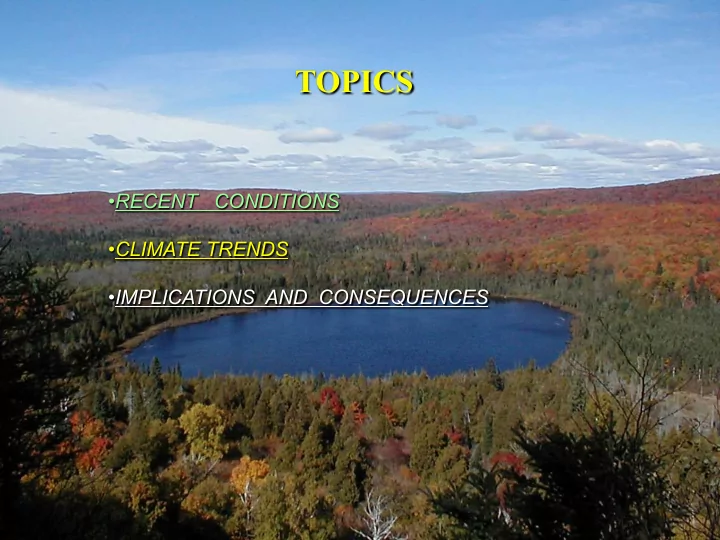

TOPICS • RECENT CONDITIONS • CLIMATE TRENDS • IMPLICATIONS AND CONSEQUENCES
Monthly mean temperature for the 48 contiguous states in 2012 vs other years back to 1895 Rank of 2012 mean annual temperature by state
2012 Drought specific disaster declarations by county-most ever Record number of counties, and record subscription to Federal Crop Insurance
MN Counties designated for federal disaster assistance in 2012 All are associated with drought except those with Which designates for flood or severe storm
RECENT SIGNIFICANT CLIMATE TRENDS IN THE WESTERN GREAT LAKES • TEMPERATURE : WARMER WITH SEASONALITY AND DIURNAL CYCLES SHIFTS • DEWPOINTS : SHIFTS IN FREQUENCY OF TROPICAL-LIKE ATMOSPHERIC WATER VAPOR • MOISTURE : AMPLIFIED PRECIPITATION SIGNAL (VARIABILITY), THUNDERSTORM CONTRIBUTION
Temp trend is upward and more frequently above the 90 th percentile
Winter (D,J,F) Spring (M,A,M) Seasonal Temperature Trends in MN Fall (S,O,N) Summer (J,J,A)
Trend in dewpoints of 70 F or higher in the Twin Cities Latitude 45 degrees Hours with dewpoints of 70 degrees F or higher at Voyageurs National Park Latitude 48.5 degrees
Frequencies of July tropical dew points (70 F or higher) and associated Heat Index values for the Twin Cities since 1945. Year Hours with DP of Range of Heat 70 F or greater Index Values (F) 1949 223 98 - 112 1987 223 98 - 104 1955 206 98 - 113 1999 192 98 – 115 (116*) 1957 192 99 – 114 2001 182 98 - 110 1977 160 100 - 108 1983 157 102 - 110 1995 110 98 - 116 2002 305 98 – 109 2004 108 98 - 105 2011 243 98 – 118 (*134) 2012 186 99 - 117
Historical Minnesota Heat Waves: Red denotes dewpoint driven 1883, 1894, 1901, 1910, 1917, 1921, 1931, 1933, 1934, 1936, 1937, 1947, 1948, 1949, 1955, 1957, 1959, 1964, 1976, 1977, 1983, 1988, 1995,1999, 2001, 2005, 2006, 2007, 2010, 2011, 2012
Historical recurrence interval of 2 inch rains in northern IA and southern MN is once per year. Observed 2 inch rainfalls for the period 1991 – 2012 and maximum single day value for various communities: Location No. 2 in. rains Maximum Value (date) Rosemount 42 5.80 (7/23/1987) Albert Lea 39 7.50 (6/15/78) Waseca 43 5.63 (9/23/2010) Winona 35 4.95 (8/19/2007) Zumbrota 43 6.46 (6/27/1998) Winnebago 41 8.64
Minnesota Statewide May Through September Precipitation Ranking of the past 19 Growing Seasons (1994-2011) Year Rank for 1895 –present statewide ave 1994 76 (18.04 ” ) 1995 84 (18.54 ” ) 1996 30 (15.55 ” ) 1997 * 61 (17.17 ” ) 1998 * 63 (17.28 ” ) 1999 * 114 (22.33 ” ) 2000 * 71 (17.58 ” ) 2001 * 48 (16.74 ” ) 2002 * 106 (21.15 ” ) 2003 32 (15.69 ” ) 2004 * 108 (21.62 ” ) 2005 * 100 (20.64 ” ) 2006 * 20 (14.63 ” ) 2007 * 68 (17.45 ” ) 2008 * 38 (16.15 ” ) 2009 10 (13.15 ” ) 2010 * 118 (24.76 ” ) 2011 64 (17.29 ” ) 2012 * 41 (16.36 ” ) * Denotes thunderstorm produced flashfloods
Shift in Precipitation Recurrence Intervals? (Three “ 1000 year events since 2004)
Consequences of Climate Change • Longer growing seasons (9-16 days longer) • Change in plant hardiness zones • Change in depth and duration of soil and lake freezing • Change in over winter survival rates of biological organisms • Opportunities for Invasive species (insects, pathogens) • Increased number of freeze/thaw cycles (damaged roads) • Longer exposure times to mold and allergens • More attention to moisture conservation, irrigation, drainage • More heat advisories and excessive heat warnings • Increased risk of soil erosion, flash flooding • Work on flood mitigation and storm sewer runoff • Growing list of impaired waters
1971-2000 Annual Mean Annual Temperature Map Decadal average annual temperature from 16 GCM models runs showing 275 mile northern migration of the 44 degrees F isotherm Source: CMIP-Lawrence-Livermore and MN State Climatology Office The A1 scenarios are of a more integrated world: characterized by: rapid economic growth; A global population that reaches 9 billion in 2050 and then gradually declines; The quick spread of new and efficient technologies; income and way of life converge between regions; extensive social and cultural interactions. A1B - A balanced emphasis on all energy sources. 1981-1 -1990 2031-2 -2040 2061-2 -2070
Recommend
More recommend